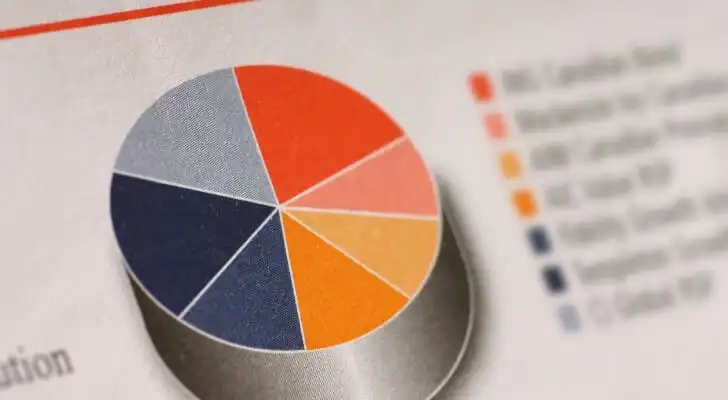
Mutual funds attract investors for many reasons. For starters, mutual funds are diversified and professionally managed investment vehicles. Their structure eliminates the need to pick securities individually and rebalance your own portfolio. But that doesn’t mean you can pass on doing your homework. There are thousands of mutual funds out there, and each aims for a different objective. You may want to consider working with a financial advisor to guide you through the world of mutual fund investing if you’re not familiar.
What Is a Mutual Fund?
A mutual fund is a professionally managed investment portfolio composed of one or more asset classes. Think of them as baskets of stocks, bonds, commodities, real estate investments and more. Mutual fund managers generally determine their asset mix based on a particular investment objective. For instance, a mutual fund that aims for long-term growth may invest entirely in stocks and high-yield bonds.
But purchasing shares of a mutual fund is different from buying shares of individual stocks and bonds. When you buy shares of a mutual fund, your money is pooled with that of others who invest in the same fund. Therefore, your return is based on the fund’s performance and the proportion of its shares you hold.
Investors may also note that these pooled investments can offer more diversification than other financial investments like exchange-traded funds (ETFs). Since mutual funds invest in a variety of securities, risk is spread across multiple assets, which aims to reduce the impact of any single security’s performance on the overall performance of the fund. However, mutual funds are subject to market volatility, which means that the fund’s value can drop during economic downturns or financial crises.
Mutual funds trade once a day. Their share prices are based on their net asset value (NAV) and computed when markets close each day. The NAV equals the total value of portfolio assets (minus any liabilities) divided by the number of outstanding shares. However, you can’t always purchase just one mutual fund share. Most mutual fund companies require minimum investments that typically stretch from $1,000 to $5,000. But the market contains several different kinds of mutual funds.
Types of Mutual Funds
It’s important to note that the market currently houses more than 7,000 mutual funds each with its own asset allocation, objective and investment strategy. So where do you start? We’ll explain some common types of mutual funds and how they work.
Stock funds invest in shares of different companies. Some stock funds focus on investing in companies of a particular market capitalization. This is the total dollar value of a company’s outstanding shares. Large-cap, for example, defines companies with more than $10 billion in market capitalization. Generally, these are well-established firms. Investing in small-cap companies, on the other hand, may involve more risk.
You can also invest in bond funds. These focus on fixed-income securities and pay interest to their shareholders on a regular basis. These funds may hold different types of debt instruments such as government, municipal or corporate bonds. The bond fund typically distributes interest payments monthly based on the underlying bonds in the mutual fund. So the income can change across different payment periods.
Some mutual funds invest in a mix of stocks, bonds or other securities. These are known as balanced funds. Managers typically keep a fixed asset allocation based on the investment strategy of the fund. This can range from conservative to aggressive depending on the fund’s objective.
Pros and Cons of Mutual Fund Investments
When you’re considering an investment in mutual funds it’s important to analyze the advantages and disadvantages that these investments could potentially bring to your portfolio. Here are the things you should consider before deciding whether mutual funds are right for you.
Pros of Investing in Mutual Funds
- Dividend potential: You can receive dividends from the fund, which you can use to invest more back into the same fund. This can help your investment value grow more rapidly.
- Diversification: Mutual funds use diversification to invest in a number of different assets, which lowers your potential risk.
- Easy access: Mutual funds are easy to understand and get access.
- Professional oversight: Mutual funds typically have a professional portfolio manager that oversees the investments of the fund.
Cons of Investing in Mutual Funds
- Taxes: The taxes can bite you when the mutual fund decides to provide distributions based on their investment choices and you have no control over it. You’ll have to pay capital gains when it happens.
- Slow trading: The trade execution time is slower than with other investments.
- High expense ratios: Expense ratios can quickly get out of hand with some mutual funds. Keep an eye out for any funds that have a higher than normal (greater than 1.50%) expense ratio and be wary of investing as it can get expensive.
How Do Mutual Fund Fees Work?

Large fees can take a major hit on mutual fund returns. In fact, one of the downsides of investing in mutual funds is that they can have complex fee structures. We’ll break it down step-by-step but oftentimes, the extent of fees involved with investing in mutual funds depends on the fund’s management strategy.
First, each mutual fund charges an annual expense ratio to cover overall operating and management expenses for the fund. Expense ratios usually range from 0.5% to 1.25%. And they’re generally calculated as a percentage of income that the fund generates. Thus, your account would face its proportional share, reducing your overall assets. In addition, some mutual fund expense ratios include 12b-1 fees to cover marketing and promotional costs. Under the law, this particular component can’t exceed 1%.
The amount that comes out of your account to cover the expense ratio is not explicitly detailed in your statements. But you can get a good glimpse of what you’re paying indirectly for fund expenses if you follow some steps. Multiply the expense ratio by the average balance invested in a 12-month period. In addition, mutual funds may charge load fees when you buy or redeem shares.
These fees are separate from the fund’s expense ratio. Load fees basically cover commissions paid to brokers and others involved in mutual fund transactions. These can span from 4% to 8% of your investment. Some mutual funds charge front-end loads, which they deduct from your initial investment when you purchase shares.
Other funds charge back-end loads when you sell your shares within a defined time span after you purchase them. Also known as deferred-sales charges, these fees generally decrease the longer you hold onto your shares until the fee disappears. For instance, the back-end load may start at 6% if you redeem your shares within a year after purchase. And it can go away after you hold on to those mutual fund shares for six years.
Active vs. Passive Mutual Funds
An actively managed mutual fund essentially tries to beat the market. The fund manager would utilize a wealth of research and analysis theories to build a mutual fund with specific securities expected to make substantial returns. It may undergo several transactions in the process. Of course, all this takes money. So active funds tend to charge large expense ratios and loads due to the complex management activity.
Passively managed funds, however, tend to track an index of different securities such as the S&P 500. This consists of the 500 U.S. companies with the biggest market capitalization. In other words, the fund aims to mimic the overall return of the S&P 500 by investing in securities that already exist within the index. So it tries to copy the market rather than beat it. As you can see, this strategy strips away much of the careful picking that’s involved with active management. As a result, passively managed funds generally charge lower fees than their active counterparts.
And while beating the market certainly sounds more lucrative than simply mirroring it, several studies indicate that actively managed funds rarely accomplish their overall goals. However, actively managed funds may be able to better hedge against risk because of their tendency to buy and sell securities when deemed necessary.
Finding the Best Mutual Funds
Some firms like Morningstar conduct extensive research on mutual funds. They can crucial data like a fund’s asset allocation, investment strategy and manager bios. Such firms will also rate mutual funds according to multiple factors, including performance considers several factors, including performance.
In addition, you can find a lot of this information laid out in the fund prospectus. This document delineates key information about a mutual fund such as its fees, expenses, asset allocation and objectives. While researching potential mutual funds to invest in, good indicators may include the following:
- A management team that has run the mutual fund for a long time
- Successful long-term performance record (but keep in mind this is no guaranteed indicator of future performance)
- Low fees compared to similar funds
Interestingly, a Morningstar study suggests that low fees may be the best predictor of mutual fund performance.
Bottom Line

Investing in mutual funds has its advantages. For starters, you eliminate the need to pick individual securities for an investment portfolio. Professional fund managers essentially do that for you and create a mutual fund with a specific growth objective. But you still need to do careful research about the mutual funds on the market. You have many to choose from, ranging from stock funds to balanced funds, that invest in several asset classes. Pay attention to fees, asset allocations, objectives and the fund managers themselves.
Tips on Mutual Fund Investing
- Because of the complexity of mutual funds, it may behoove you to seek the guidance of a financial advisor. Finding a financial advisor doesn’t have to be hard. SmartAsset’s free tool matches you with up to three vetted financial advisors who serve your area, and you can interview your advisor matches at no cost to decide which one is right for you. If you’re ready to find an advisor who can help you achieve your financial goals, get started now.
- Mutual fund fees can take huge chunks off your returns, which is why you should research investing costs with laser precision. But one good place to start might be with index funds. These passively managed funds generally charge lower fees than actively managed ones.
Photo credit: ©iStock.com/benedek, ©iStock.com/Jirapong Manustrong, ©iStock.com/LiudmylaSupynska